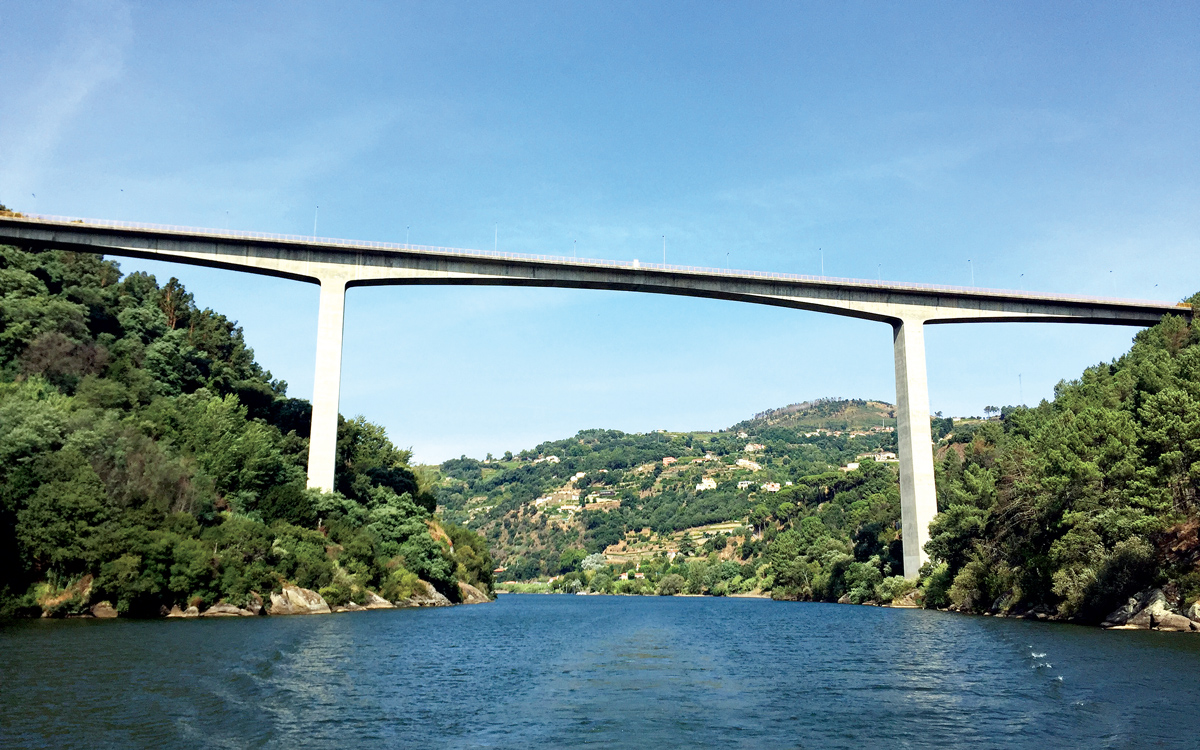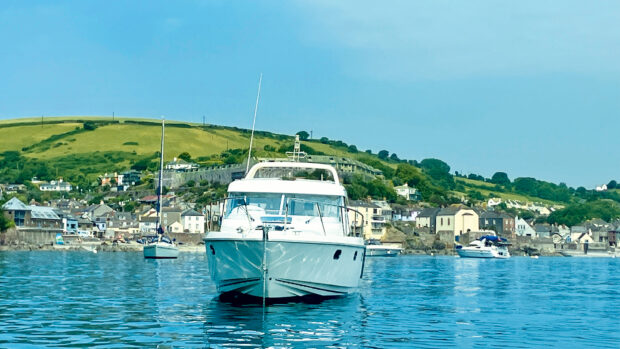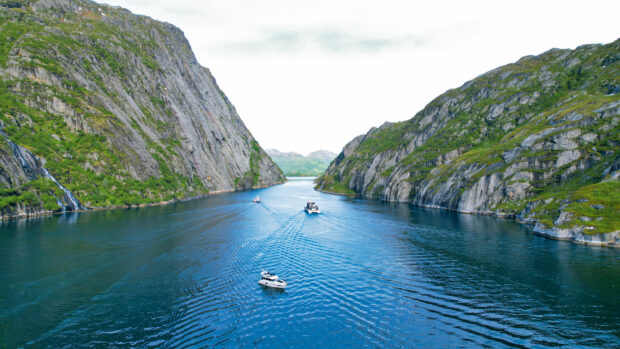Andrew Smyth and Corinne Julius fulfil a long held ambition to cruise Portugal’s Douro River in their Broom 42 CL.
I’d first read about the Douro River many years ago and it had always sounded like the kind of remote place I wanted to explore. Since then it has become popular with river cruise companies but it’s still not an easy place to visit in one’s own boat. Never ones to shirk a challenge, my wife Corinne and I decided that this was to be the highlight of our cruise down to the Algarve from Falmouth.
It’s not just a dramatic destination, the river has played an important part in Britain’s history as the source of port from the vineyards lining the upper river valley. The fortified wine was originally brought down the 60 miles to Porto in flat-bottomed wooden craft, braving the dangerous rapids en route, but these days a series of dams and locks have tamed the water making it navigable for 120 miles into Spain.
The river is now a UNESCO World Heritage site and the wine is transported by road tankers, leaving the old boats for tourist trips.

One of the many beautiful houses on the river with their own private berths
Leaving Falmouth, we already knew France’s west coast well, so it took us only a few days to reach Spain and turn west and head for La Coruna. Here we could slow down a bit and visit many of the fascinating fishing villages along the coast as well as cruising the Atlantic Rias before crossing into Portugal at Bayona.
After another overnight stop at Viano de Castello, the fog descended and we motored in 100m visibility to the entrance to Porto, where the little boats fishing in the entrance appeared completely oblivious to any danger.
We had been calling the Douro Marina consistently but had no answer until we were almost inside, when a boat emerged from the fog and led us to a berth where it finally cleared. It wasn’t a good start but the marina more than redeemed themselves over the next few days with a helpfulness that made our river trip possible.
Article continues below…

Cruising around Gibraltar: Exploring the gateway to the Mediterranean

Cruising Europe on a 40ft boat: Bavaria owners share their Holland to Ibiza adventure
Although I’d planned this cruise to Portugal for months beforehand, I still had little idea what to expect upriver. There was almost nothing I was able to find out about it so I had no idea how easy or difficult it would be to find overnight berths or even anchorages, nor whether we would be able to get ashore. But the biggest obstacle, of course, were the locks – five of them – all of which had to be booked for a specific opening at least 24 hours in advance.
And one Englishman we met, who kept his boat locally, told us that when he’d missed his booking time, he’d had to wait another 24 hours before he could make a second reservation. Clearly, you had to get it right. That in itself presented major problems because I didn’t know how long we should allow for each stretch of the river.
Booking the locks can only be done online but the website was in Portuguese and required Portuguese tax details before we could register.

The concrete facade of Crestuma lock, 15 miles upriver from Porto
Apparently, navigation is managed through Leixoes, the commercial port just to the north of Porto, whose ships usually use agents. I can see why. After trying to arrange things myself, I finally gave up and asked the marina management if they could make the bookings for us.
Initially they were reluctant to help because they would have to make an immediate payment for it but, realising there was no way we could do it ourselves, they asked for my itinerary to lodge with the river authorities, telling me that I had only an hour before they shut.
Using the only small guide to the river I had, I made a quick spreadsheet showing the distances between the locks and calculated the time between them. The river cruisers go at around 12 knots, which I thought ridiculously fast – what’s the hurry? – but with the prettiest vineyards past the third lock in Pinhão, I decided on a reasonably quick ascent to here at around 8 knots, after which we could slow down to make the most of the views.
I calculated the likely times we would reach the locks and took our proposed itinerary back to the marina office for them to deal with.
Last-minute tinkering
Meanwhile, a replacement windlass motor that I’d ordered from the UK had arrived at the marina and this presented another challenge. I’m not the most skilled mechanic at the best of times, despite the kind of blue-water cruising I favour being known as ‘mending your boat in exotic locations’.
There was a small boatyard attached to the marina but they had no one available and since we were leaving for the Douro the next day, I had little choice but to roll up my sleeves and do the work myself. I finally managed to install the new motor and bolt it back on, only to discover that I’d put it on back to front so I had to redo everything for the second time.
I don’t know what the neighbouring boats thought of my language but I sincerely hope they didn’t speak the kind of English I resorted to. Eventually, I finished the job just in time to go and pick up our daughter Carla from the airport, who had flown in to join us for this part of our cruise. She’d spent a long weekend in Porto the previous year so didn’t mind heading straight inland the following day.

The marina confirmed our lock reservations and hit me with a charge of €350 – €35 per lock – which was a bit of a shock, but at least we were booked. They gave me the schedule we’d agreed along with a map containing a mileage chart and allowed us to photograph a guide that the local boat hire company gave to their clients, giving recommendations for the restaurants, which we hoped would be an essential part of our trip.
Our navigation systems on Freya use an interfaced laptop along with a Navionics chartplotter and we discovered that the Navionics cartridge covered inland waterways, including the entire navigable length of the Douro. This meant we were able to chart not just the course of the river but also the depth for anchoring.
This was good news as we’d discovered that there was no prohibition on anchoring and we could stop wherever we wanted to. It also became clear that there were numerous alternative possibilities for overnight mooring if anchorages weren’t available, as most of the villages along the river were trying to attract visitors by laying on public pontoons, even if some of them are rickety. In addition there were private pontoons where an overnight stop wouldn’t offend the owners.

“We headed upriver and anchored in the deep stillness of the encroaching night”
With all preparations made, we set off inland for the first lock at Crestuma, 14 miles upriver. These lower reaches still had the look and feel of a seaside resort with several sandy beaches along the banks complete with deckchairs and umbrellas.
We even passed a large holiday camp with huts lining the bank and an Olympic sized swimming pool. The terminal for the huge river cruisers is just outside the city, although fortunately we didn’t encounter as many of these as we’d feared.
One surprising feature of the river is the number of striking modernist homes built along the banks, some even featuring self-rusting steel walls. This, along with the elegant slender bridges which cross the river, revealed a modern side of Portugal we hadn’t expected.

One of the many contemporary bridges spanning the Douro
Imposing entrance
The next lock wasn’t booked until the evening, so we had plenty of time to stop for lunch and Carla was desperate to take on board some bacalão (salt cod) washed down with vinho verde. There was a cramped pontoon by a riverside restaurant, where we managed to moor alongside the dilapidated hammerhead – or rather what was left of it.
Sitting on their terrace overlooking the river, I finally felt I could relax from making plans. All we had to do now was be at Carrapatelo by 17:30 that evening.
The locks on the Douro are huge but if we thought the first lock was daunting Carrapatelo, another 20 miles upstream, is the deepest in Europe with a rise and fall of 35 metres. The adjacent power station has three turbines producing 63 megawatt hours each – enough for nearly 10,000 homes.

The Carrapatelo lock is the deepest in Europe
As we entered the lock, the daylight disappeared and the concrete walls towered over us with the tiny figure of the lock keeper silhouetted against what little we could see of the sky. The gates in these bigger locks lift up and the first time we passed underneath one we were drenched by the water running off it. Later, when sharing a lock with one of the river cruise boats, it was amusing to see the passengers on deck being soaked, having ignored the warnings.
The locks are large enough to take several of the smaller day-cruise boats, even with us hanging on alongside. The leviathan river cruise ships, on the other hand, have to manoeuvre carefully to get in and appear to ignore the normal rules of passing. At one stage we met one of them when coming out of a lock and, leaving them to port, we got stuck between them and the rocks to starboard. Alarming as it was to us, they didn’t seem too bothered about it.
In fact, mooring in the locks is actually easier than many canals, despite the depth. Floating bollards are fixed into grooves in the walls and the water doesn’t swirl around, so it’s a dignified rise up into daylight. I noted that the lock keepers asked everyone entering the name of the boat and how many passengers were on board but they didn’t seem to be checking it against any list, which made me wonder.

Some of the Douro’s vineyard terracing dates back to Roman times
Sampling the wine region
With the evening staying light until late, we had plenty of time to find an overnight stop and were able to spend the first night on a private, secluded pontoon where our only company were clouds of mayfly-like insects attracted by our lights.
We had to sweep them off the decks the next morning before our midday appointment at the Eclusa de Régua, 50 miles from Porto, at the start of the wine growing region. It is just beyond this lock that the Douro’s best known restaurant, DOC, is perched over the river at Folgosa, but at €90 a head plus expensive wine we thought we’d better look for somewhere more affordable.
From here on the valleys were covered with vineyards – the rows of vines reaching from the river banks to the top of the hills on either side. The magnificent buildings of the quintas, proudly bearing their names above, were scattered around, but it was hot, very hot and there were few signs of life aside from several buzzards circling overhead.

The terrace of Douro’s finest restaurant, DOC, enjoys spectacular views of the river
Pinhão is the hub of the wine-growing region and used to be the base for the boats that went down to Porto. These days it’s more of a tourist destination and on the itinerary of all the cruise ships. Like the rest of the area, it’s surrounded by vineyards, with one, Quinta da Bomfim, very close to where we moored Freya.
At this time of year, in mid-summer before the harvest, there wasn’t much to see but videos of the workers treading the grapes – which they do even now – was fascinating.
The historic relationship between Douro wines and Britain is illustrated by the fact that Bomfim is owned by the Anglo-Portuguese Symington family, who have been here for generations but have all been educated in the UK. A Union flag hung limply at a house up beyond the main buildings and the video inside emphasised that this was still a family operation with the various brothers giving introductions in English, rather than Portuguese.

Quinta do Bomfim vineyard
Symington’s is one of the largest, owning well-known labels such as Dow’s, Graham’s and Cockburns, although they also produce straightforward Douro wines from their many quintos in the area. After the tour we headed upriver again and anchored in a bend of the river, out of sight of any habitation and in the deep stillness of the encroaching night.
The next reach, above the Eclusa de Valeira, was our last, taking us up to the far edge of the wine-growing area at Ribeira, 80 miles from Porto. This was a much wilder reach, very narrow in places, where we had to wait on one stretch for a tourist boat to pass through.
It gave an indication of what the river had been like before the locks, with rapids and shallows close by us on either side. We stopped at another neighbourhood restaurant where someone came out to help us move the sunken hull obstructing the jetty.

The new season’s wine is stored in wood barrels
He had a South African accent but told us he came originally from Angola, the former Portuguese colony riven by civil war. He was now running an engine repair business successful enough to have financed a large motor cruiser. If I’d known earlier, I would have asked him to fit my windlass!
An enjoyable journey’s end
Saturday lunchtime is when all the local families come out to eat and a long table running down the centre of the restaurant gradually filled up with customers. We noticed the people closest to us were speaking English. “That’s the Symingtons,” Corinne said. “I recognise them from the video.”
We confirmed this afterwards when we caught up with the younger generation making for their speedboat, which was moored next to us. It’s hard to say who was more surprised; us for sitting next to the owners of all these vineyards or them for finding out we’d cruised here from the UK on our own boat.

The couple’s Broom 42 CL Freya on a private pontoon in Pinhao
After lunch it was time to head back for our evening booking through Valeira lock. We had dinner under the stars in another quiet anchorage before heading down the next day to drop off Carla for a taxi back to the airport. There’s no speed limit on the river so we decided to speed up a bit from our usual 8 knots.
I’d booked the return through the Régua lock for just after midday but that would still leave us quite a way from Porto. Remembering that no one appeared to check our booking, we turned up for an earlier opening and tried to look innocent. Sure enough the lock keeper only asked for the number on board and we got through.
We got back to Aregas, where there was a large marina, in time for a quick lunch before a taxi took Carla to the airport. We anchored again that night but as evening came, the wind rose to gale force as it funnelled through the river valley.

“Porto turned out to be just as magical as the Douro itself”
Fortunately, our anchor held but it was an anxious night made more frustrating when we found the reach just around the corner had virtually no wind. We headed back through the Crestuma lock and back to Porto Marina where we were welcomed like long-departed family.
We spent our last few days touring Porto, which was almost as magical as the Douro itself. We had to turn away touts offering trips up the river – we’d already done it and in our own boat!
First published in the January 2021 issue of Motor Boat & Yachting.
If you enjoyed this…
Be first to all the latest boats, gadgets, cruising ideas, buying advice and readers’ adventures with a subscription to Motor Boat & Yachting. Available in both print and digital formats, our monthly magazine will be sent directly to your home or device at a substantial discount to the usual cover price. See our latest offers and save at least 30% off the cover price.

Wines from the quintas are now taken to Porto by road rather than specially designed boats

The Canvodero resort on the lower reaches of the Douro










